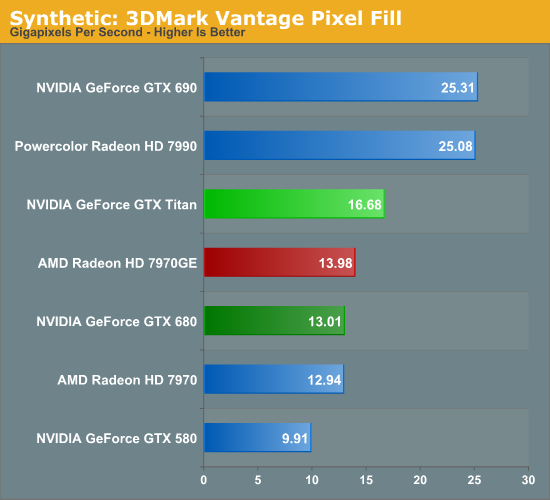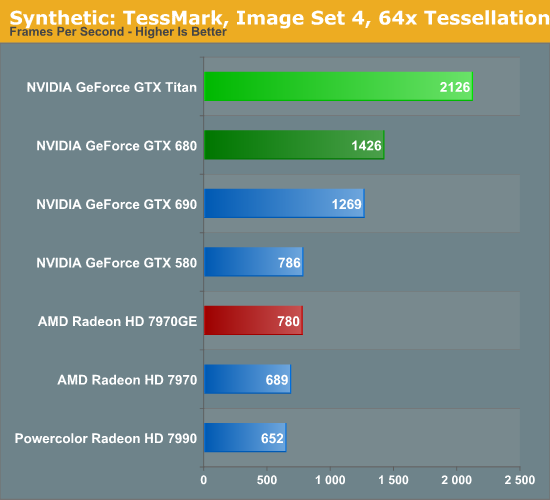NVIDIA’s GeForce GTX Titan Review, Part 2: Titan's Performance Unveiled
by Ryan Smith & Rahul Garg on February 21, 2013 9:00 AM ESTSynthetics
As always we’ll also take a quick look at synthetic performance to get a better look at Titan’s underpinnings. These tests are mostly for comparing cards from within a manufacturer, as opposed to directly comparing AMD and NVIDIA cards. We’ll start with 3DMark Vantage’s Pixel Fill test.

Pixel fill is a mix of a ROP test and a test to see if you have enough bandwidth to feed those ROPs. At the same time the smallest increase in theoretical performance for Titan over GTX 680 was in ROP performance, where a 50% increase in ROPs was met with a minor clockspeed reduction for a final increase in ROP performance of 25%.
The end result is that with gains of 28%, Titan’s lead over GTX 680 is just a hair more than its increase in theoretical ROP performance. Consequently at first glance it looks like Titan has enough memory and cache bandwidth to feed its 48 ROPs, which given where we’re at today with GDDR5 is good news as GDDR5 has very nearly run out of room.
Moving on, we have our 3DMark Vantage texture fillrate test, which does for texels and texture mapping units what the previous test does for ROPs.

Oddly enough, despite the fact that Titan’s texture performance improvements over GTX 680 were only on the range of 46%, here Titan is measured as having 62% more texturing performance. This may be how Titan is interplaying with its improved bandwidth, or it may be a case where some of the ancillary changes NVIDIA made to the texture paths for compute are somehow also beneficial to proper texturing performance.
Finally we’ll take a quick look at tessellation performance with TessMark.

Unsurprisingly, Titan is well ahead of anything else NVIDIA produces. At 49% faster it’s just a bit over the 46% theoretical performance improvement we would expect from the increased number of Polymorph Engines the extra 6 SMXes bring. Interestingly, as fast as GTX 580’s tessellation performance was, these results would indicate that Titan offers more than a generational jump in tessellation performance, nearly tripling GTX 580’s tessellation performance. Though at this time it’s not at all clear just what such tessellation performance is good for, as we seem to be reaching increasingly ridiculous levels.










337 Comments
View All Comments
chizow - Friday, February 22, 2013 - link
Idiot...has the top end card cost 2x as much every time? Of course not!!! Or we'd be paying $100K for GPUs!!!CeriseCogburn - Saturday, February 23, 2013 - link
Stop being an IDIOT.What is the cost of the 7970 now, vs what I paid for it at release, you insane gasbag ?
You seem to have a brainfart embedded in your cranium, maybe you should go propose to Charlie D.
chizow - Saturday, February 23, 2013 - link
It's even cheaper than it was at launch, $380 vs. $550, which is the natural progression....parts at a certain performance level get CHEAPER as new parts are introduced to the market. That's called progress. Otherwise there would be NO INCENTIVE to *upgrade* (look this word up please, it has meaning).You will not pay the same money for the same performance unless the part breaks down, and semiconductors under normal usage have proven to be extremely venerable components. People expect progress, *more* performance at the same price points. People will not pay increasing prices for things that are not essential to life (like gas, food, shelter), this is called the price inelasticity of demand.
This is a basic lesson in business, marketing, and economics applied to the semiconductor/electronics industry. You obviously have no formal training in any of the above disciplines, so please stop commenting like a ranting and raving idiot about concepts you clearly do not understand.
CeriseCogburn - Saturday, February 23, 2013 - link
They're ALREADY SOLD OUT STUPID IDIOT THEORIST.LOL
The true loser, an idiot fool, wrong before he's done typing, the "education" is his brainwashed fried gourd Charlie D OWNZ.
chizow - Sunday, February 24, 2013 - link
And? There's going to be some demand for this card just as there was demand for the 690, it's just going to be much lower based on the price tag than previous high-end cards. I never claimed anything otherwise.I outlined the expectations, economics, and buying decisions in general for the tech industry and in general, they hold true. Just look around and you'll get plenty of confirmation where people (like me) who previously bought 1, 2, 3 of these $500-650 GPUs are opting to pass on a single Titanic at $1000.
Nvidia's introduction of an "ultra-premium" range is an unsustainable business model because it assumes Nvidia will be able to sustain this massive performance lead over AMD. Not to mention they will have a harder time justifying the price if their own next-gen offering isn't convincingly faster.
CeriseCogburn - Tuesday, February 26, 2013 - link
You're not the nVidia CEO nor their bean counter, you whacked out fool.You're the IDIOT that babbles out stupid concepts with words like "justifying", as you purport to be an nVidia marketing hired expert.
You're not. You're a disgruntled indoctrinated crybaby who can't move on with the times, living in a false past, and waiting for a future not here yet.
Oxford Guy - Thursday, February 21, 2013 - link
The article's first page has the word luxury appearing five times. The blurb, which I read prior to reading the article's first page has luxury appearing twice.That is 7 uses of the word in just a bit over one page.
Let me guess... it's a luxury product?
CeriseCogburn - Tuesday, February 26, 2013 - link
It's stupid if you ask me. But that's this place, not very nVidia friendly after their little didn't get the new 98xx fiasco, just like Tom's.A lot of these top tier cards are a luxury, not just the Titan, as one can get by with far less, the problem is, the $500 cards fail often at 1920x resolution, and this one perhaps can be said to have conquered just that, so here we have a "luxury product" that really can't do it's job entirely, or let's just say barely, maybe, as 1920X is not a luxury resolution.
Turn OFF and down SOME in game features, and that's generally, not just extreme case.
People are fools though, almost all the time. Thus we have this crazed "reviews" outlook distortion, and certainly no such thing as Never Settle.
We're ALWAYS settling when it comes to video card power.
araczynski - Thursday, February 21, 2013 - link
too bad there's not a single game benchmark in that whole article that I give 2 squirts about. throw in some RPG's please, like witcher/skyrim.Ryan Smith - Thursday, February 21, 2013 - link
We did test Skyrim only to ultimately pass on it for a benchmark. The problem with Skyrim (and RPGs in general) is that they're typically CPU limited. In this case our charts would be nothing but bar after bar at roughly 90fps, which wouldn't tell us anything meaningful about the GPU.